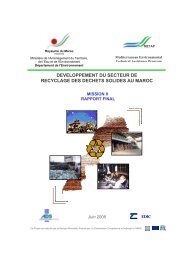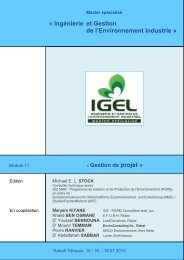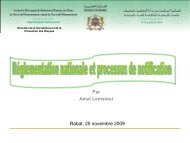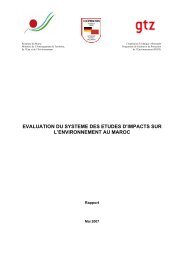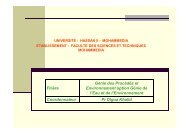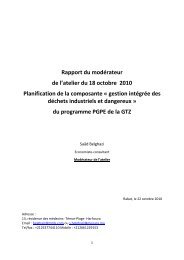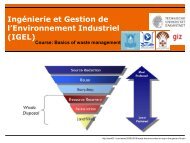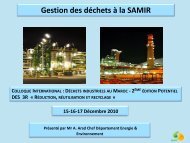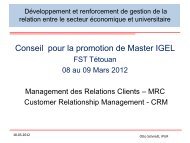Ingénierie et Gestion de l'Environnement Industriel ... - GD MAROC
Ingénierie et Gestion de l'Environnement Industriel ... - GD MAROC
Ingénierie et Gestion de l'Environnement Industriel ... - GD MAROC
Create successful ePaper yourself
Turn your PDF publications into a flip-book with our unique Google optimized e-Paper software.
Ingénierie <strong>et</strong> <strong>Gestion</strong> <strong>de</strong>l’Environnement <strong>Industriel</strong>(IGEL)Course: Basics of waste managementhttp://earth911.com/news/2009/03/09/waste-hierarchy-whos-on-top-in-the-game-of-trash/
First Impressions of MoroccoFirst lectures in Marrakech09/01/2012 | Group of waste management and waste technology | Institute IWAR | Prof. Dr. Uwe Lahl2
Unit 1: IntroductionContents1. Introduction2. Syllabus3. Basics4. Germany, history5. Glossary6. Glossary in use7. Summary09/01/2012 | Group of waste management and waste technology | Institute IWAR | Prof. Dr. Uwe Lahl 3
Unit 1: Introduction2. SyllabusWe have some overarching aims with the course.The most important is, to be open for new unconventional i<strong>de</strong>as.To be critical with respect to arguments that will be announced asimmovable.Be able to use the learned facts and figures without a teacher.Be open for topics in the waste sector, that adressing non-technicalmore political or social aspects.See technologies as m<strong>et</strong>hods for social and economical <strong>de</strong>velopment.09/01/2012 | Group of waste management and waste technology | Institute IWAR | Prof. Dr. Uwe Lahl4
Unit 1: Introduction2. Syllabus, to bridge the gapSituation inMorroccoBAT from EU09/01/2012 | Group of waste management and waste technology | Institute IWAR | Prof. Dr. Uwe Lahl5
Unit 1: Introduction2. Syllabus• And more concr<strong>et</strong>e: Aim of this lecture is, to learn the basic know-howof a waste management system.• Objectif <strong>de</strong> ce cours est d'apprendre les base du savoir-faire d'un système <strong>de</strong> gestion <strong>de</strong>s déch<strong>et</strong>s• The theor<strong>et</strong>ical informations are complemented by excursions to anindustrial company and to a selected landfill.• Les informations théoriques sont complétées par <strong>de</strong>s excursions à une société industrielle <strong>et</strong> à une décharge sélectionné.• Apart from the excursions there are also some exercises to practice th<strong>et</strong>heor<strong>et</strong>ical informations of the lectures.• Outre les excursions il ya aussi quelques exercices pour pratiquer les informations théoriques sur les conférences.• In addition we have prepared two tests to check the success of theselectures.• En outre, nous avons préparé <strong>de</strong>ux tests pour vérifier le succès <strong>de</strong> ces conférences.• These tests will show us how good or even not so good, we were able toconvey the information in the lectures and exercises to you.• Ces tests vont nous montrer comment bien ou pas si bon, nous avons été en mesure <strong>de</strong> transm<strong>et</strong>tre l'information dans les cours <strong>et</strong> lesexercices pour vous.09/01/2012 | Group of waste management and waste technology | Institute IWAR | Prof. Dr. Uwe Lahl7
Unit 1: Introduction2. Syllabus• The first task consists in an introduction to the basics of wastemanagement in or<strong>de</strong>r to obtain an overview of all additional necessaryconditions of waste management systems.• La première tâche consiste en une introduction aux bases <strong>de</strong> la gestion <strong>de</strong>s déch<strong>et</strong>s afin d'obtenir un aperçu <strong>de</strong> toutes les conditionssupplémentaires nécessaires pour les systèmes <strong>de</strong> gestion <strong>de</strong>s déch<strong>et</strong>s.• In the first lectures important terms of waste management are presented(with a glossary provi<strong>de</strong>d from the GIZ). This Glossary inclu<strong>de</strong>s allnecessary terms of a waste management system.• Dans les premières conférences termes importants <strong>de</strong> la gestion <strong>de</strong>s déch<strong>et</strong>s sont présentées (avec un glossaire fourni par le GIZ).Ce glossaire comprend tous les termes nécessaires d'un système <strong>de</strong> gestion <strong>de</strong>s déch<strong>et</strong>s.• Stu<strong>de</strong>nts will learn which different kinds of waste still exist.• Les étudiants apprennent ce que différents types <strong>de</strong> déch<strong>et</strong>s existent toujours.• They will learn which different types of waste treatment are in use and what ar<strong>et</strong>he differences b<strong>et</strong>ween them (composting, digestion, incineration).• Ils vont apprendre ce qui les différents types <strong>de</strong> traitement <strong>de</strong>s déch<strong>et</strong>s sont utilisés <strong>et</strong> quelles sont les différences entre eux(compostage, digestion, incinération).• The basic know-how and the Glossary are the bases of this lectures.• La base du savoir-faire <strong>et</strong> le glossaire sont les bases <strong>de</strong> ce cours.09/01/2012 | Group of waste management and waste technology | Institute IWAR | Prof. Dr. Uwe Lahl8
Unit 1: Introduction2. Syllabushttp://www.startupgreece.gov.gr09/01/2012 | Group of waste management and waste technology | Institute IWAR | Prof. Dr. Uwe Lahl9http://www.pollutionissues.com
Unit 1: Introduction2. Syllabus• In the following lecture the stu<strong>de</strong>nts will g<strong>et</strong> to know the frameworkconditions of different countries. You already know the frameworkconditions of Morocco. With Germany and the European Union, twoexamples of different approaches are given for waste management. Bothexamples stand for a very good quality of waste management.• Dans la prochaine conférence, les élèves verront connaître les conditions cadres <strong>de</strong> différents pays. Vous connaissez déjà lesconditions cadres du Maroc. Avec l'Allemagne <strong>et</strong> l'Union européenne, <strong>de</strong>ux exemples d'approches différentes sont données pour lagestion <strong>de</strong>s déch<strong>et</strong>s. Les <strong>de</strong>ux exemples reposer pendant une très bonne qualité <strong>de</strong> la gestion <strong>de</strong>s déch<strong>et</strong>s.• These examples are compared with the international level of wastemanagement. You will see the difference and the need of wastemanagement systems.• Ces exemples sont comparées avec le niveau international <strong>de</strong> gestion <strong>de</strong>s déch<strong>et</strong>s. Vous allez voir la différence <strong>et</strong> la nécessité <strong>de</strong>systèmes <strong>de</strong> gestion <strong>de</strong>s déch<strong>et</strong>s.09/01/2012 | Group of waste management and waste technology | Institute IWAR | Prof. Dr. Uwe Lahl10
Unit 1: Introduction2. Syllabushttp://www.typeer.<strong>de</strong>09/01/2012 | Group of waste management and waste technology | Institute IWAR | Prof. Dr. Uwe Lahl11http://myzerowaste.com
Unit 1: Introduction2. Syllabus• With the next lecture the risks of different wastes will be shown.• Avec la prochaine conférence <strong>de</strong>s risques <strong>de</strong> différents déch<strong>et</strong>s seront affichés.• Disposal of waste is a very important theme. Waste dumped on landfillscan have high influence on people who are living in the vicinity and on theenvironment, if the waste is not treated in an appropriate manner..• L'élimination <strong>de</strong>s déch<strong>et</strong>s est un thème très important. Les déch<strong>et</strong>s sur les décharges peuvent avoir une gran<strong>de</strong> influence sur lespersonnes vivant dans le voisinage <strong>et</strong> sur l'environnement, si les déch<strong>et</strong>s ne sont pas bien traités.• You will see which kinds of landfills still exist and for which types ofwastes they are used for.• Vous allez voir quels types <strong>de</strong> décharges existent encore, <strong>et</strong> pour quels types <strong>de</strong> déch<strong>et</strong>s qu'ils sont utilisés.• Each waste has different influences on the environment and theseinfluences are shown to the stu<strong>de</strong>nts. You will see how dangerous wastecan be and what is the right way for disposal.• Chaque déch<strong>et</strong> a différentes influences sur l'environnement <strong>et</strong> ces influences sont présentés aux élèves. Vous verrez comment lesdéch<strong>et</strong>s peuvent être dangereux <strong>et</strong> ce qui est <strong>de</strong> la bonne façon pour l'élimination.09/01/2012 | Group of waste management and waste technology | Institute IWAR | Prof. Dr. Uwe Lahl12
Unit 1: Introduction2. Syllabus• Now you know, how to dump treated waste, but you still have to learn about thewaste treatment. Traitement <strong>de</strong>s déch<strong>et</strong>s• The treatment of waste starts with the generation of waste in private households.Even private households can have a influence on their waste generation. (Selfcomposting, reusing things,…)• In mo<strong>de</strong>rn soci<strong>et</strong>y the generation of waste cannot be totally prevented. Eachcitizen will produce waste and this waste has to be treated.• The aim of waste treatment is to protect mankind before waste-born risks(infections by pathogens, contamination of water, soil, air and food) as well asbefore risks generated by the treatment itself (e.g. emissions). Further aims areprotection of the environment and saving of resources with closed-loop recycling.• The first step of treatment is collection and transport of the generated waste. Bothhave to follow special rules. Special transport and collecting systems are used.Traitement, collecte <strong>et</strong> le transport <strong>de</strong>s déch<strong>et</strong>s générés.• You will learn about the different collection systems and which system is used forwhich type of waste. Différents systèmes <strong>de</strong> collecte <strong>et</strong> le système qui est utilisé pour les déch<strong>et</strong>s.09/01/2012 | Group of waste management and waste technology | Institute IWAR | Prof. Dr. Uwe Lahl14
Unit 1: Introduction2. Syllabushttp://thumbs.dreamstime.com09/01/2012 | Group of waste management and waste technology | Institute IWAR | Prof. Dr. Uwe Lahl15http://www.awv.steiermark.at
Unit 1: Introduction2. Syllabus• The collected waste still is not save for people or the environment and therefore ithas to be treated in different ways.• Les déch<strong>et</strong>s collectés sont toujours pas épargner pour la nature <strong>et</strong> doit être traitée <strong>de</strong> différentes manières.• You will see the different types of waste treatment, starting with the mechanicaltreatment, biological treatment to thermal treatment of waste. You will experiencewhich waste has to be treated in which way. les différents types <strong>de</strong> traitement <strong>de</strong>s déch<strong>et</strong>s encommençant par le traitement mécanique, à l'épuration biologique <strong>et</strong> à le traitement thermique• Every treatment process is shown in a d<strong>et</strong>ailed way. All positive and negativeeffects of these treatments on the environment will be shown. Measures tominimize these effects will be also discussed.• While showing the treatment processes, the treatment aggregates are alsoexplained. The aim of explaining the operating mechanisms of these aggregatesis, that you comprehend what happens with the waste insi<strong>de</strong> the plant. You willsee, which effects different aggregates have on the waste and which are theadvantages and disadvantages of these aggregates.09/01/2012 | Group of waste management and waste technology | Institute IWAR | Prof. Dr. Uwe Lahl16
Unit 1: Introduction2. Syllabushttp://www.wurzer-umwelt.<strong>de</strong>09/01/2012 | Group of waste management and waste technology | Institute IWAR | Prof. Dr. Uwe Lahl17http://www.hauert-duenger.<strong>de</strong>
Unit 1: Introduction2. Syllabus• With the information about logistic of waste management (collection system,transport, treatment and disposal), the next step will be to construct an owntreatment plant based on the past lectures. It is not the aim that the stu<strong>de</strong>nts areenabled to plan a treatment plant with the knowledge provi<strong>de</strong>d here. The aim isthat you know which steps are important for planning a treatment plant. This isthe base for future engineering tasks.• Avec l'information sur la logistique <strong>de</strong> gestion <strong>de</strong>s déch<strong>et</strong>s (système <strong>de</strong> collecte, transport, traitement <strong>et</strong> élimination), la prochaineétape sera <strong>de</strong> construire une usine <strong>de</strong> traitement propres sur la base <strong>de</strong>s conférences passées. Ce n'est pas le but d'être en mesure<strong>de</strong> planifier une usine <strong>de</strong> traitement avec les connaissances fournies ici. C'est le but <strong>de</strong> savoir quelles mesures sont importantes pourla planification d'une usine <strong>de</strong> traitement. C'est la base pour <strong>de</strong>s tâches <strong>de</strong> l'ingénierie d‟avenir.• The lectures start with the basics of waste management and ends with theknow-how of planning and constructing treatment plants.• Les conférences commencent avec les bases <strong>de</strong> la gestion <strong>de</strong>s déch<strong>et</strong>s <strong>et</strong> se termine avec le savoir-faire <strong>de</strong> la planification <strong>et</strong> laconstruction d'usines <strong>de</strong> traitement09/01/2012 | Group of waste management and waste technology | Institute IWAR | Prof. Dr. Uwe Lahl18
Unit 1: Introduction2. Syllabus, course-scheduleSecond week lectures09/01/2012 | Group of waste management and waste technology | Institute IWAR | Prof. Dr. Uwe Lahl20
Unit 1: Introduction2. Syllabus, course-schedule, d<strong>et</strong>ailsExample: Biological treatment plant in Germany Station <strong>de</strong> traitement biologique en Allemagnehttp://www.awsas.<strong>de</strong>/cm/images1/kompostwerk_luftbild09.jpg09/01/2012 | Group of waste management and waste technology | Institute IWAR | Prof. Dr. Uwe Lahl 24
Unit 1: Introduction2. Syllabus, course-schedule, d<strong>et</strong>ails• UE 7: Thermal treatment traitement thermique• In this lecture the combination of different types of treatment concepts will be discussed, especially the MBTtechnologyis presented. The pros and cons of this technologies will be explained.• Dans c<strong>et</strong>te conférence <strong>de</strong> la combinaison <strong>de</strong> différents types <strong>de</strong> concepts <strong>de</strong> traitement seront discutés, notamment le MBT-technology est présenté. Lesavantages <strong>et</strong> les inconvénients <strong>de</strong> c<strong>et</strong>te technologie seront expliquée• The concepts for production of refuse <strong>de</strong>rived fuels (rdf) will be explained. Practical examples of mo<strong>de</strong>rn plants arepresented.• The stu<strong>de</strong>nts will see how the efficiency of treatment plant <strong>de</strong>pends on the different concepts.• UE 8: Planning of waste treatment plants la planification d'installations <strong>de</strong> traitement <strong>de</strong>s déch<strong>et</strong>s• This lecture should give an overview of the necessary aspects for the construction of a waste treatment plant.(Dimension the storage of a treatment plant, the fermenter unit or burning unit).• C<strong>et</strong>te conférence <strong>de</strong>vrait donner un aperçu <strong>de</strong>s aspects nécessaires à la construction d'une usine <strong>de</strong> traitement <strong>de</strong>s déch<strong>et</strong>s. (Dimension du stockage d'uneusine <strong>de</strong> traitement, l'unité <strong>de</strong> fermentation ou d'une unité <strong>de</strong> brûlure).• The structure of planning processes is presented. The structure of authorizations for building plants in Europe isexplained• Le processus <strong>de</strong> planification <strong>et</strong> la structure <strong>de</strong>s autorisations pour la construction <strong>de</strong>s stations en Europe seront présenté <strong>et</strong> expliqué.09/01/2012 | Group of waste management and waste technology | Institute IWAR | Prof. Dr. Uwe Lahl25
Unit 1: Introduction2. Syllabus, course-schedule, d<strong>et</strong>ailsExample: Solid waste incineration plant of Kassel (Germany)09/01/2012 | Group of waste management and waste technology | Institute IWAR | Prof. Dr. Uwe Lahlhttp://www.mhkw-kassel.<strong>de</strong>/mhkw/Das_MHKW/Schematische_Darstellung/Schematische_Darstellung_k_neu.gif26
Unit 1: Introduction2. Syllabus, course-schedule, d<strong>et</strong>ails• UE 9 and 10: Basics of waste management in economic termsBases <strong>de</strong> la gestion <strong>de</strong>s déch<strong>et</strong>s en termes économiques• Lectures 9 and 10 <strong>de</strong>al with economic aspects of waste management like planning, organizing andfinancing.• Conférences 9 <strong>et</strong> 10 sont traitant <strong>de</strong>s aspects économiques <strong>de</strong> la gestion <strong>de</strong>s déch<strong>et</strong>s, comme la planification, l'organisation <strong>et</strong> lefinancement.• UE 9: Basics of waste management in economic terms (1)This lecture gives an introduction of the topic and <strong>de</strong>als with the economics of environmentalpolicy and the preparing of waste management plans (structure and elements, planning process, sources,streams and facilities, responsibilities and last but not least economy and financing).Chapter 1: Introduction to the subjectChapter 2: The economics of environmental policy L'économie <strong>de</strong> la politique environnementaleChapter 3: Waste management plans Plans <strong>de</strong> gestion <strong>de</strong>s déch<strong>et</strong>s09/01/2012 | Group of waste management and waste technology | Institute IWAR | Prof. Dr. Uwe Lahl27
Unit 1: Introduction2. Syllabus, course-schedule, d<strong>et</strong>ails• UE 10: Basics of waste management in economic terms (2)This lecture <strong>de</strong>als with the organization and the financing of waste management systems (municipal wastemanagement, private sector participation, financing and cost recovery and last but not least with thecharacteristics, financial and organizational requirements and investments in low-and middle incomecountries).C<strong>et</strong>te conférence traite <strong>de</strong> l'organisation <strong>et</strong> le financement <strong>de</strong>s systèmes <strong>de</strong> gestion <strong>de</strong>s déch<strong>et</strong>s (gestion <strong>de</strong>s déch<strong>et</strong>s municipaux, la participation du secteur privé, lefinancement <strong>et</strong> le recouvrement <strong>de</strong>s coûts <strong>et</strong> enfin <strong>et</strong> surtout pas avec les caractéristiques, les exigences financières <strong>et</strong> organisationnelles <strong>et</strong> <strong>de</strong>s investissementsdans les pays à revenu faible <strong>et</strong> intermédiaire)Chapter 1: Financing and organization of municipal waste management systems and private sectorparticipation in the EUFinancement <strong>et</strong> organisation <strong>de</strong>s systèmes municipaux <strong>de</strong> gestion <strong>de</strong>s déch<strong>et</strong>s <strong>et</strong> la participation du secteur privé dans l'UEChapter 2: Waste treatment costs for land filling, sorting, BT, MBT, RDF and incineration in the EUcoûts <strong>de</strong> traitement <strong>de</strong>s déch<strong>et</strong>s, <strong>de</strong> tri, BT, MBT, RDF <strong>et</strong> l'incinération dans l'UEChapter 3: Characteristics and financial and organizational requirements in low and middle incomecountries Caractéristiques <strong>et</strong> exigences financières <strong>et</strong> organisationnelles <strong>de</strong>s pays à revenu faible <strong>et</strong> intermédiaire09/01/2012 | Group of waste management and waste technology | Institute IWAR | Prof. Dr. Uwe Lahl28
Unit 1: Introduction2. Syllabus, course-schedule, d<strong>et</strong>ailshttp://www.savoy-truffle.<strong>de</strong>09/01/2012 | Group of waste management and waste technology | Institute IWAR | Prof. Dr. Uwe Lahl29http://www.comedix.<strong>de</strong>
Unit 1: Introduction3. BasicsInfluences on a waste management system –area related aspects• For effective waste management systems, you need to know what are theconditions of the implementation area• The following structure shows the influence aspects on the wastemanagement systemPour <strong>de</strong>s systèmes efficaces <strong>de</strong> gestion <strong>de</strong>s déch<strong>et</strong>s, vous <strong>de</strong>vez savoir quelles sont les conditions <strong>de</strong> la zone <strong>de</strong> mise en œuvreLa structure ci-<strong>de</strong>ssous montre les aspects d'influence sur le système <strong>de</strong> gestion <strong>de</strong>s déch<strong>et</strong>s09/01/2012 | Group of waste management and waste technology | Institute IWAR | Prof. Dr. Uwe Lahl30
Unit 1: Introduction3. BasicsFor implementation of an effective wastemanagement system, you have to know:Pour la mise en œuvre d'un système efficace <strong>de</strong> gestion <strong>de</strong>s déch<strong>et</strong>s,vous <strong>de</strong>vez connaître:• Natural conditions• Demographic conditions• Structural conditions• Technical conditions• Economical conditions• And legal requirementsWith the view on these conditions, you have to g<strong>et</strong>to know the strengths and weaknesses of thedifferent conditions. Out of these know-how, youhave to calculate and plan your waste managementsystem with chosen measures and technologies.09/01/2012 | Group of waste management and waste technology | Institute IWAR | Prof. Dr. Uwe LahlUmweltbun<strong>de</strong>samt: Best practice municipal waste management31
Unit 1: Introduction3. BasicsInfluences on a waste management system –area related aspects• Next to these different conditions, it is necessary to have an eye on thegeographical area (terms of population, accessibility, structure oftransport n<strong>et</strong>works, commercial and industrial diversity,…)• A côté <strong>de</strong> ces différentes conditions, il est nécessaire d'avoir un œil sur la zone géographique (termes <strong>de</strong> population, l'accessibilité, lastructure <strong>de</strong>s réseaux <strong>de</strong> transport, <strong>de</strong> la diversité commerciale <strong>et</strong> industrielle, ...)• You have to know local particularities and constrains of the area• You have to know all territorial features• I<strong>de</strong>ntify the differences of this special area09/01/2012 | Group of waste management and waste technology | Institute IWAR | Prof. Dr. Uwe LahlUmweltbun<strong>de</strong>samt: Best practice municipal waste management32
Unit 1: Introduction3. BasicsInfluences on a waste management system –area related aspects• For <strong>de</strong>scribing a special area you have to <strong>de</strong>al with certain criteria• Pour décrire une zone spéciale vous <strong>de</strong>vez traiter certains critères• To the group of stratification criteria are inclu<strong>de</strong>d:1. Structure of dwelling Structure d'habitation2. Structure of heating Structure <strong>de</strong> chauffage3. Commercial structure Structure commerciale4. Transport n<strong>et</strong>work Réseaux <strong>de</strong> transport5. Industrial structure Structure industrielle6. Regional particularities Particularités régionales09/01/2012 | Group of waste management and waste technology | Institute IWAR | Prof. Dr. Uwe LahlUmweltbun<strong>de</strong>samt: Best practice municipal waste management33
Unit 1: Introduction3. BasicsInfluences on a waste management system –area related aspects1. Structure of dwelling• Population and building aspects are important forthis criteria• Depending on the population and size of the area,the building structure can be different• Selon la population <strong>et</strong> la taille <strong>de</strong> la zone, la structure du bâtiment peut être différent• Four different building structure types can bedistinguished:• Building structure type I: Estates of high-rise multiunit resi<strong>de</strong>ntial buildings high population09/01/2012 | Group of waste management and waste technology | Institute IWAR | Prof. Dr. Uwe LahlUmweltbun<strong>de</strong>samt: Best practice municipal waste management34
Unit 1: Introduction3. Basics• Building structure type II: Attached multi unit resi<strong>de</strong>ntial buildingssmaller number of living units, than building structure I lower populationLa structure du bâtiment <strong>de</strong> type II:Attaché bâtiments rési<strong>de</strong>ntiels àlogements multiples p<strong>et</strong>it nombre d'unités<strong>de</strong> vie, que la structure du bâtiment I la population faible• Building structure type III: D<strong>et</strong>ached multi unit resi<strong>de</strong>ntial buildings smaller numbers of living units than in building structure I and II good infrastructure, many gar<strong>de</strong>ns around the buildings09/01/2012 | Group of waste management and waste technology | Institute IWAR | Prof. Dr. Uwe LahlUmweltbun<strong>de</strong>samt: Best practice municipal waste management35
Unit 1: Introduction3. Basics• Building structure type IV: D<strong>et</strong>ached and semid<strong>et</strong>ached one or two familybuildings poor infrastructure greater distance b<strong>et</strong>ween the buildings• Détaché <strong>et</strong> mitoyenne d'un ou <strong>de</strong>ux bâtiments familiy l'insuffisance <strong>de</strong>s infrastructures plus gran<strong>de</strong> distance entre les bâtimentsUmweltbun<strong>de</strong>samt: Best practice municipal waste management09/01/2012 | Group of waste management and waste technology | Institute IWAR | Prof. Dr. Uwe Lahl36
Unit 1: Introduction3. BasicsIf you have to compare these building structure types, you have to knowthat from Type I to Type IV:Si vous avez <strong>de</strong> comparer ces types <strong>de</strong> structure du bâtiment, vous <strong>de</strong>vez savoir que <strong>de</strong> type I au type IV• The population <strong>de</strong>creases La population diminue• The infrastructure g<strong>et</strong>s worse L'infrastructure se détériore• The traffic n<strong>et</strong> g<strong>et</strong>s worse• The amount of wastes <strong>de</strong>creases• The unemployment of the people increases (more poor people)• …Umweltbun<strong>de</strong>samt: Best practice municipal waste management09/01/2012 | Group of waste management and waste technology | Institute IWAR | Prof. Dr. Uwe Lahl37
Unit 1: Introduction3. BasicsEffects on the waste management system:Eff<strong>et</strong>s sur le système <strong>de</strong> gestion <strong>de</strong>s déch<strong>et</strong>s• Composition and volume of the waste composition <strong>et</strong> volume <strong>de</strong> déch<strong>et</strong>s• Possibilities for source separation and home composting of wasteLes possibilités <strong>de</strong> tri à la source <strong>et</strong> le compostage à domicile <strong>de</strong>s déch<strong>et</strong>s• Suitable waste container types and sizes• Appropriate waste charging schemes and fee mo<strong>de</strong>lsDéch<strong>et</strong>s approprié <strong>de</strong>s systèmes <strong>de</strong> tarification <strong>et</strong> <strong>de</strong> modèles <strong>de</strong> taxesUmweltbun<strong>de</strong>samt: Best practice municipal waste management09/01/2012 | Group of waste management and waste technology | Institute IWAR | Prof. Dr. Uwe Lahl38
Unit 1: Introduction3. Basics2. Structure of heating• The manner of heating has an influence on the composition of the waste Le mo<strong>de</strong><strong>de</strong> chauffage a une influence sur la composition <strong>de</strong>s déch<strong>et</strong>s• Private households are free in the way of using their waste (long as legislationdoesn´t ban)Les ménages privés ont choisi d'utiliser leurs déch<strong>et</strong>s, comment ils aiment• E.g. the waste can be burned in heater (oven) (or the waste can be used forcombustion)Par exemple les déch<strong>et</strong>s peuvent être brûlés dans <strong>de</strong>s chauffe-eau (au four) (ou les déch<strong>et</strong>s peuvent être utilisés pour lacombustion)Umweltbun<strong>de</strong>samt: Best practice municipal waste management09/01/2012 | Group of waste management and waste technology | Institute IWAR | Prof. Dr. Uwe Lahl39
Unit 1: Introduction3. BasicsEffects on the waste management system:Eff<strong>et</strong>s sur le système <strong>de</strong> gestion <strong>de</strong>s déch<strong>et</strong>s• Composition and volume of the waste Composition <strong>et</strong> le volume <strong>de</strong>s déch<strong>et</strong>s• Suitable waste container types Convient types <strong>de</strong> conteneurs <strong>de</strong> déch<strong>et</strong>s• Applicable options for waste treatment Options applicables au traitement <strong>de</strong>s déch<strong>et</strong>sUmweltbun<strong>de</strong>samt: Best practice municipal waste management09/01/2012 | Group of waste management and waste technology | Institute IWAR | Prof. Dr. Uwe Lahl40
Unit 1: Introduction3. Basics3. Commercial structure• The intensity of industrial and commercial activities has a big influence on thecomposition and volume of the generated wasteL'intensité <strong>de</strong>s activités industrielles <strong>et</strong> commerciales a une gran<strong>de</strong> influence sur la composition <strong>et</strong> le volume <strong>de</strong>s déch<strong>et</strong>s générésEffects:• Composition and volume of waste Composition <strong>et</strong> le volume <strong>de</strong> déch<strong>et</strong>s• Possibilities for waste collection and separationLes possibilités <strong>de</strong> collecte <strong>de</strong> déch<strong>et</strong>s <strong>et</strong> <strong>de</strong> la séparation• Suitable collection arrangements (pick-up or bring system)Modalités <strong>de</strong> collecte appropriés• Appropriate waste charging schemes and fee mo<strong>de</strong>lsUmweltbun<strong>de</strong>samt: Best practice municipal waste management09/01/2012 | Group of waste management and waste technology | Institute IWAR | Prof. Dr. Uwe Lahl41
Unit 1: Introduction3. Basics4. Transport n<strong>et</strong>work réseau <strong>de</strong> transport• The available traffic system is very important forthe planning of a waste management system• Le système <strong>de</strong> trafic disponibles est très important pour la planification d'unsystème <strong>de</strong> gestion <strong>de</strong>s déch<strong>et</strong>s• You have to know:• The transport ways (stre<strong>et</strong>, water, railways)• The structure of these ways (Are they suitable forthe planned waste collection?)• Is the traffic n<strong>et</strong>work full utilized or not?Umweltbun<strong>de</strong>samt: Best practice municipal waste management09/01/2012 | Group of waste management and waste technology | Institute IWAR | Prof. Dr. Uwe Lahl42
Unit 1: Introduction3. BasicsTraffic in MoscowTraffic in Pakistanhttp://icp.ge.ch/dip/langues/allemand/bil<strong>de</strong>r/mobilitat/VerkehrMoskauhttp://www.mormo.<strong>de</strong>/050208-Lahore_Punjab_Pakistan/Pfer<strong>de</strong>karren_im_Verkehr.jpg09/01/2012 | Group of waste management and waste technology | Institute IWAR | Prof. Dr. Uwe Lahl43
Unit 1: Introduction3. BasicsEffects on the waste management system:• Suitable collection arrangements• Modalités <strong>de</strong> collecte approprié• Type of suitable vehicles and transportation chains• Need for local disposal solutions, temporary storage and transfer stations• Besoin <strong>de</strong> solutions d'élimination locales, le stockage temporaire <strong>et</strong> <strong>de</strong> stations <strong>de</strong> transfertUmweltbun<strong>de</strong>samt: Best practice municipal waste management09/01/2012 | Group of waste management and waste technology | Institute IWAR | Prof. Dr. Uwe Lahl44
Unit 1: Introduction3. Basics5. Industrial structure• Existing industries d<strong>et</strong>ermine the possibilities for recycling of certaincomponents, influences the opportunities for other forms of disposal andstructure <strong>de</strong>velopments• Les industries existantes détermine les possibilités pour le recyclage <strong>de</strong> certains composants• Transportation aspect• Generation of special waste types• Génération <strong>de</strong>s types <strong>de</strong> déch<strong>et</strong>s spéciauxUmweltbun<strong>de</strong>samt: Best practice municipal waste management09/01/2012 | Group of waste management and waste technology | Institute IWAR | Prof. Dr. Uwe Lahl45
Unit 1: Introduction3. Basics6. Regional particularities:• Tourism areas• zone touristique• Protected zones (nature conservation areas)• Topographic particularities (mountains, w<strong>et</strong>land)• Special zones (country bor<strong>de</strong>rs)Yellow stonenational parkhttp://www.nordbayerischer-kurier.<strong>de</strong>09/01/2012 | Group of waste management and waste technology | Institute IWAR | Prof. Dr. Uwe Lahlwww.<strong>de</strong>stination360.com/north-america/us/wyoming46
Unit 1: Introduction4. Germany, historySince when has Germany compiled middle/long term planning on municipalwaste management?Programme <strong>de</strong> gestion <strong>de</strong>s déch<strong>et</strong>s ‟75 du gouvernement fédéral09/01/2012 | Group of waste management and waste technology | Institute IWAR | Prof. Dr. Uwe Lahl47
Unit 1: Introduction4. Germany, historyThe period from a disor<strong>de</strong>red to the current waste management situation inGermany was not overcome in one single planning step.La pério<strong>de</strong> à partir d'un désordre à la situation actuelle <strong>de</strong> gestion <strong>de</strong>s déch<strong>et</strong>s en Allemagne n'a pas été surmonté en uneseule étape <strong>de</strong> planification uniqueThis period inclu<strong>de</strong>s more than 30 years and was characterized by differentmajor planning steps, with varying success.C<strong>et</strong>te pério<strong>de</strong> comprend plus <strong>de</strong> 30 ans <strong>et</strong> a été caractérisée par différentes étapes <strong>de</strong> planification majeur, avec un succèsvariable.From this experience recommendations are <strong>de</strong>rived to give advice to theGovernment of emerging countries.De c<strong>et</strong>te expérience sont issus <strong>de</strong>s recommandations pour donner <strong>de</strong>s conseils Gouvernement <strong>de</strong>s pays émergents.09/01/2012 | Group of waste management and waste technology | Institute IWAR | Prof. Dr. Uwe Lahl 48
Unit 1: Introduction4. Germany, historyAt the beginning of last century, waste management in Germany was not wellorganized. This situation lasted to the 1960s. The relevant unit which wasresponsible for waste disposal was the lowest administration level: themunicipalities down to the small villages. As a consequence, a few thousand opendumps were in operation. These so-called „mayor„s dumps“ were without any kindof environmental protection measure.The first important step towards a proper waste management was to <strong>de</strong>fine theresponsibilities and to raise the general responsibility to b<strong>et</strong>ter performing levels ofadministration.At the beginning of the 1970s, the counties and the cities were ma<strong>de</strong> responsible toestablish central landfills. As part of this assignment minimum technicalrequirements for these landfills were <strong>de</strong>fined.Au début du siècle <strong>de</strong>rnier en Allemagne gestion <strong>de</strong>s déch<strong>et</strong>s n'a pas été bien organisé. C<strong>et</strong>te situation s'est poursuivie jusqu'aux années 1960.L'unité qui a pris l'élimination <strong>de</strong>s déch<strong>et</strong>s a été le plus bas niveau administratif, les municipalités jusqu'aux p<strong>et</strong>its villages. Par conséquent, il y avaiten Allemagne quelques milliers <strong>de</strong> décharges à ciel ouvert sans aucune sorte <strong>de</strong> conscience environnementale.La première étape importante vers une gestion appropriée <strong>de</strong>s déch<strong>et</strong>s a été <strong>de</strong> définir les responsabilités <strong>et</strong> <strong>de</strong> relever <strong>de</strong> la responsabilité généralepour les niveaux plus performants <strong>de</strong> l'administration.Au début <strong>de</strong>s années 1970, les comtés <strong>et</strong> les villes ont été chargés d'établir <strong>de</strong>s sites d'enfouissement central. Dans le cadre <strong>de</strong> c<strong>et</strong>te cessionexigences techniques minimales pour ces décharges ont été définis.09/01/2012 | Group of waste management and waste technology | Institute IWAR | Prof. Dr. Uwe Lahl49
Unit 1: Introduction4. Germany, historyIt took many years to take and to implement this<strong>de</strong>cisions. One reason for this was the fact that thelocal governments, who ma<strong>de</strong> the final <strong>de</strong>cisionse.g. concerning the locations, were running every5 years to be re-elected. And they were afraid tomake themselves unpopular with the localpopulation at the concerned site. Therefore, notalways the most appropriate locations wereselected, mostly the <strong>de</strong>cisions were ma<strong>de</strong> byhttp://www.echo-online.<strong>de</strong>mixed by political and technical criteria.Since the <strong>de</strong>cision to build a central waste landfill have not been linked to benefitsor penalties to the <strong>de</strong>cision-makers in some counties, it took very long to take<strong>de</strong>cisions.A key lesson from this early period is that you have to organize within the planningprocess also advantages and disadvantages for no-<strong>de</strong>cisions.Depuis la décision <strong>de</strong> construire une décharge <strong>de</strong> déch<strong>et</strong>s centrale n'était pas liée à <strong>de</strong>s prestations ou <strong>de</strong>s sanctions pour les déci<strong>de</strong>urs dans certains comtés, il a fallutrès longtemps pour prendre <strong>de</strong>s décisions.Une <strong>de</strong>s principales leçons <strong>de</strong> c<strong>et</strong>te première pério<strong>de</strong>, c'est que vous avez à organiser au sein du processus <strong>de</strong> planification a également <strong>de</strong>s avantages <strong>et</strong> <strong>de</strong>sinconvénients pour aucune <strong>de</strong>s décisions.09/01/2012 | Group of waste management and waste technology | Institute IWAR | Prof. Dr. Uwe Lahl50
Unit 1: Introduction4. Germany, historyStep by step the necessary <strong>de</strong>cisions were ma<strong>de</strong>.Peu à peu les décisions nécessaires ont été faites.In this phase the media were helpful which reported about the intolerableconditions at the old landfill sites.Dans c<strong>et</strong>te phase les médias ont été utiles, qui a signalé les conditions intolérables dans les sites d'enfouissement ancienneA very convincing action was ma<strong>de</strong> from the magazine „Stern“ which broughtyellow waste drums to a lot of local landfills with the inscription: „Waste fromSeveso acci<strong>de</strong>nt“ - without any problems.Environmental NGOs were also helpful, putting localgovernments un<strong>de</strong>r pressure.Les ONG environnementales ont aussi été utiles, en m<strong>et</strong>tant les gouvernements locaux sous pression.http://www.greenpeace.<strong>de</strong>/typo3temp/GB/9fb6be39b8.jpg09/01/2012 | Group of waste management and waste technology | Institute IWAR | Prof. Dr. Uwe Lahl51
Unit 1: Introduction4. Germany, historyEnd of the 1970s, the resistance or the protest against central landfill sitesincreased dramatically among local populations. This <strong>de</strong>velopment coinci<strong>de</strong>dwith a flare-up of a general discussion on environmental protection in Germany.Fin <strong>de</strong>s années 1970, la résistance ou la protestation contre les décharges centrale considérablement augmenté parmi lapopulation locale. C<strong>et</strong>te évolution a coïncidé avec une flambée d'une discussion générale sur la protection <strong>de</strong> l'environnement enAllemagne.Environmental NGOs supported this protest with essentially two key <strong>de</strong>mands:Les ONG environnementales soutenu c<strong>et</strong>te manifestation avec essentiellement <strong>de</strong>ux exigences principales• There is only landfilling - waste prevention and recycling do not occur.• The standard of the landfill(s) is not high enough, there are (or will be)pollution and in consequence environmental damage and health risks.09/01/2012 | Group of waste management and waste technology | Institute IWAR | Prof. Dr. Uwe Lahl 52
Unit 1: Introduction4. Germany, historyGovernment's response after many years of controversial <strong>de</strong>bate was creating acompl<strong>et</strong>e s<strong>et</strong> of rules for closed-loop recycling („Circular Economy“) and higherstandards for landfills. Both rules have not been <strong>de</strong>veloped in one step, but grew inseveral (som<strong>et</strong>imes very heated) discussions with the public.In addition, cities and counties were or<strong>de</strong>red to inclu<strong>de</strong> their means and policies onthe waste sector into so-called Integrated Waste Management Concepts. TheGerman Bun<strong>de</strong>slän<strong>de</strong>r were obliged, too, to <strong>de</strong>velop overarching wastemanagement concepts. All concepts had to be discussed with the public.One lesson from this period is that site selection should be b<strong>et</strong>ter ma<strong>de</strong> incombination with integrated concepts. Furthermore, it has proven useful to discusswaste concepts in and with the public, as this increases the pressure for necessary<strong>de</strong>cisions on the local level.Une leçon <strong>de</strong> c<strong>et</strong>te pério<strong>de</strong> est que la sélection du site doit être mieux fait en combinaison avec <strong>de</strong>s concepts intégrés. Par ailleurs, ils'est avéré utile pour discuter <strong>de</strong>s concepts <strong>de</strong> déch<strong>et</strong>s dans <strong>et</strong> avec le public, car cela augmente la pression pour <strong>de</strong>s décisionsnécessaires au niveau local.09/01/2012 | Group of waste management and waste technology | Institute IWAR | Prof. Dr. Uwe Lahl53
Unit 1: Introduction4. Germany, historyGIZ: Draft „Manual Industrial Waste – Low and Middle iIncome Economies“09/01/2012 | Group of waste management and waste technology | Institute IWAR | Prof. Dr. Uwe Lahl 54
Unit 1: Introduction4. Germany, history55Exten<strong>de</strong>d Producer Responsibility (ERP): The packaging waste exampleResponsabilité élargie <strong>de</strong>s producteurs (ERP): Exemple d'emballage <strong>de</strong>s déch<strong>et</strong>s• > 100 Mio t. sales packagings collected since 1993• high recycling quotas09/01/2012 | Group of waste management and waste technology | Institute IWAR | Prof. Dr. Uwe Lahl55Rummler 2010
Unit 1: Introduction4. Germany, historyDespite the broad technical requirements for landfills like high-quality sealingsystems, resistance to disposal sites was not stopped. Explaining this is a complexsociological issue.This led to the so-called professional multi-barrier concept, in whose course thewaste itself was attributed as a barrier. In this context, the step was not far off toquestioning the dumping of untreated waste.In the beginning of the 1990„s it was required as part of an administrative regulation(TA Siedlungsabfall) that waste with a maximum of 5% of residual organic content(measured as ignition loss) may work as a barrier.A central lesson of this phase is that waste pre-treatment is primarily a <strong>de</strong>mand thatwill help to improve the environmental saf<strong>et</strong>y of disposal sites. Today, of course,climate protection and energy recovery of waste are important criteria in additionand often even dominate the argumentation.Malgré les gran<strong>de</strong>s exigences techniques pour les décharges, comme les systèmes d'étanchéité <strong>de</strong> haute qualité, résistance auxsites d'élimination n'a pas été arrêté. Pour expliquer cela est une question complexe sociologique. Cela a conduit à la soi-disantprofessionnels multi-barrières concept, dont le cours du déch<strong>et</strong> lui-même, a été attribuée comme un obstacle. Dans ce contexte,l'étape n'était pas loin à un interrogatoire du déversement <strong>de</strong> déch<strong>et</strong>s non traités.09/01/2012 | Group of waste management and waste technology | Institute IWAR | Prof. Dr. Uwe Lahl56
Unit 1: Introduction4. Germany, historyMulti-barrier-concept for minimizing emissions from landfill sites09/01/2012 | Group of waste management and waste technology | Institute IWAR | Prof. Dr. Uwe Lahl 57GIZ, Waste manual,draft 2011
Unit 1: Introduction4. Germany, historyThe requirement "5% residual organic content" in waste can only be m<strong>et</strong> by thermalpre-treatment (waste incineration). Out of this a long-standing dispute aboutimplementation of this administrative act (TA Siedlungsabfall) <strong>de</strong>veloped. Step bystep the counties and cities invested in waste treatment, mainly in incinerators. Butas at that time (late 1990s) waste incineration had its own environmental problems(high emissions), the public discussion focused now on waste incineration.Then the government reacted by significantly strengthening the emission regulationfor waste incineration (17. BImSchV).L'exigence <strong>de</strong> "5% <strong>de</strong> contenu organique résiduelle" ne peut être satisfaite par les déch<strong>et</strong>s pré-traitement thermique (incinération <strong>de</strong>sdéch<strong>et</strong>s).Mais comme à ce moment-incinération <strong>de</strong>s déch<strong>et</strong>s (fin <strong>de</strong>s années 1990) avait ses propres problèmes environnementaux (émissionsélevées), le débat public centré maintenant sur l'incinération <strong>de</strong>s déch<strong>et</strong>s.An important lesson from this phase is not to fall back behind the Europeanrequirements regarding waste incineration standards.09/01/2012 | Group of waste management and waste technology | Institute IWAR | Prof. Dr. Uwe Lahl 58
Unit 1: Introduction4. Germany, historyEmissions from waste incineration in GermanyLes émissions provenant <strong>de</strong> l'incinération <strong>de</strong>s déch<strong>et</strong>s en Allemagne(per 100 000 t of MSW)210,000 t NO X410,000 t SO 2180 kg Cd130 kg Hg6 g Dioxin36,000 t NO X0.9 t SO 21.2 kg Cd1.2 kg Hg0.003 g Dioxinbefore 1990todayWeltzin; 201009/01/2012 | Group of waste management and waste technology | Institute IWAR | Prof. Dr. Uwe Lahl 59
Unit 1: Introduction4. Germany, historyIn addition to incineration there arose other proposals <strong>de</strong>signed to pre-treat wastein a way that it works as the required barrier. It also me<strong>et</strong>s the requirements of theWaste Recycling and Management Law. The main proposal was the Mechanical-Biological Treatment (MBT). En plus <strong>de</strong> l'incinération il s'éleva autres propositions visant à pré-traiter les déch<strong>et</strong>sd'une manière qu'il fonctionne comme la barrière requises <strong>et</strong> satisfait également aux exigences <strong>de</strong> la loi recyclage <strong>de</strong>s déch<strong>et</strong>s <strong>et</strong> <strong>de</strong>gestion. La proposition principale est le traitement mécano-biologique (TMB).The government initially did not respond on this. For years the view remained thatthe 5% ignition loss criterion is the only one for proving the suitability of pre-treatedwaste for landfilling. This led to a polarization of positions and to a <strong>de</strong>cision jam inmany local governments. Since the combustion in spite of the stringentenvironmental protection requirements remained to be controversial among thepublic. This <strong>de</strong>cision jam can be explained by the fact that local politicians had theimpression that they would be forced from the central government into theincineration path way. Although there exist b<strong>et</strong>ter alternatives.09/01/2012 | Group of waste management and waste technology | Institute IWAR | Prof. Dr. Uwe Lahl 60
Unit 1: Introduction4. Germany, historyAt the beginning of this millennium, the government ma<strong>de</strong> a new attempt to breakthis <strong>de</strong>adlock. A s<strong>et</strong> of rules was created which ma<strong>de</strong> also MBT acceptable as apre-treatment technique before disposal. However, the requirements for MBT weres<strong>et</strong> in a way that it is „equivalent“ for the barrier function and also for the emissionsto waste incineration. As a result, since then more than 40 MBT plants were built inGermany. The aim was to keep the standards not only for the treated waste, alsofor airborn and water emissions. But today waste is mainly treated in wasteincineration plants (about 70 plants). Waste treatment now is fully implemented(2011). An important result is that the <strong>de</strong>mand for landfill space could besignificantly reduced thereby.It is recommen<strong>de</strong>d that in an emerging country for the implementation of wast<strong>et</strong>reatment, MBT should be permitted as an alternative to waste incineration, but atan emission level equivalent to that of incineration.Il est recommandé que dans un pays émergent pour la mise en œuvre du traitement <strong>de</strong>s déch<strong>et</strong>s, MBT <strong>de</strong>vraient être autorisées en tantqu'alternative à l'incinération <strong>de</strong>s déch<strong>et</strong>s, mais à un niveau équivalent à celui <strong>de</strong>s émissions <strong>de</strong> l'incinération.09/01/2012 | Group of waste management and waste technology | Institute IWAR | Prof. Dr. Uwe Lahl 61
Unit 1: Introduction4. Germany, historyRecycling (Incl. Composting) Waste-to-Energy LandfillingSource: EUROSTAT09/01/2012 | Group of waste management and waste technology | Institute IWAR | Prof. Dr. Uwe Lahl 62
Unit 1: Introduction4. Germany, historyHave Germany ever encountered publicresistance during the construction of wastedisposal/treatment facilities (especiallyincineration facilities)?http://bil<strong>de</strong>r.nw-news.<strong>de</strong>Through what ways to gain public trust and tog<strong>et</strong> the project done smoothly.http://www.kirchenkreis-pa<strong>de</strong>rborn.<strong>de</strong>09/01/2012 | Group of waste management and waste technology | Institute IWAR | Prof. Dr. Uwe Lahlhttp://www.grosshansdorf.<strong>de</strong>/images/a_bau_mva_<strong>de</strong>mo3.jpg63
The Circle of ProtestsUnit 1: Introduction4. Germany, history09/01/2012 | Group of waste management and waste technology | Institute IWAR | Prof. Dr. Uwe Lahl 64© Fußer 2010
Unit 1: Introduction4. Germany, historyThere has been consi<strong>de</strong>rable resistance in the population against theexpansion of facilities for waste management.Il a été une résistance considérable <strong>de</strong> la population contre l'expansion <strong>de</strong>s installations <strong>de</strong> gestion <strong>de</strong>s déch<strong>et</strong>s.There were protests against all the major waste facilities. Protests werelargest when against waste incineration and landfill sites.Il ya eu <strong>de</strong>s protestations contre toutes les installations <strong>de</strong> déch<strong>et</strong>s importants. Les protestations ont été le plus importantcontre l'incinération <strong>de</strong>s déch<strong>et</strong>s <strong>et</strong> <strong>de</strong>s décharges.Government has reacted to important objections with legal improvements.On site, an open policy of information has led to the best results.Le gouvernement a réagi à <strong>de</strong>s objections importantes avec <strong>de</strong>s améliorations juridiques. Sur place, une politique ouverte <strong>de</strong>l'information a eu les meilleurs résultats.But there is no guarantee for the success of a project.Mais il n'ya aucune garantie pour la réussite d'un proj<strong>et</strong>09/01/2012 | Group of waste management and waste technology | Institute IWAR | Prof. Dr. Uwe Lahl 65
Unit 1: Introduction4. Germany, historyDynamics of Protests09/01/2012 | Group of waste management and waste technology | Institute IWAR | Prof. Dr. Uwe Lahl66© Fußer 2010
Unit 1: Introduction4. Germany, historyBefore studying the potential or actual social conflict levels and the relevantactors, a critical analysis of site selection is meaningful.Avant d'étudier les niveaux potentiels ou réels conflits sociaux <strong>et</strong> les acteurs concernés, une analyse critique du choix du site estsignificatif.You are in a comfortable position, if there has been a transparent selection of themost appropriate location pred<strong>et</strong>ermined by objective criteria.On est dans une position confortable, si il ya eu une sélection transparente <strong>de</strong> l'emplacement le plus approprié prédéterminés par <strong>de</strong>scritères objectifs.If such a procedure has not taken place, the legitimacy of the location <strong>de</strong>cision isweaker.Si une telle procédure n'a pas eu lieu, la légitimité <strong>de</strong> la décision d'implantation est plus faible.But in any case, it should be clear, given by all project participants also jointlysupported argument why the chosen location is suitable.Mais en tout cas, elle doit être claire, donnée par tous les participants au proj<strong>et</strong> a également soutenu conjointement argumentexpliquant pourquoi l'emplacement choisi est approprié.09/01/2012 | Group of waste management and waste technology | Institute IWAR | Prof. Dr. Uwe Lahl 67
Unit 1: Introduction4. Germany, historyThe clue of transparent public relations is to inform as early as possible,without providing the project itself is damaged.In fact, you cannot answer at the beginning of a project all the technical issuesand concerns that have come from the citizens, because the plans have notbeen compl<strong>et</strong>ed, y<strong>et</strong>. But one can represent the situation as it is.L'indice d'une relation transparente publique est d'informer le plus tôt possible, sans fournir le proj<strong>et</strong> lui-même est endommagé.En fait, vous ne pouvez pas répondre au début d'un proj<strong>et</strong> <strong>de</strong> toutes les questions techniques <strong>et</strong> les préoccupations qui ont été<strong>de</strong>s citoyens, parce que les plans n'ont pas été achevées, <strong>et</strong> pourtant. Mais on peut se représenter la situation comme elle est.09/01/2012 | Group of waste management and waste technology | Institute IWAR | Prof. Dr. Uwe Lahl 68
Unit 1: Introduction4. Germany, historyIn this early phase, the official representative or the promoters of a projectshould not hesitate to hold personal interviews with those affected.In an early phase, it is also possible to start thinking and planning on abalance of interests.Som<strong>et</strong>imes there are only small requests to the technical planning, apotential activists can be satisfied easily and the result will then beinterpr<strong>et</strong>ed as a fair compromise.Dans c<strong>et</strong>te première phase, le représentant officiel ou les promoteurs d'un proj<strong>et</strong> ne doit pas hésiter à mener <strong>de</strong>s entr<strong>et</strong>ienspersonnels avec les personnes touchées.Dans une première phase, il est également possible <strong>de</strong> commencer à penser <strong>et</strong> à planifier sur un équilibre <strong>de</strong>s intérêts.Parfois, il n'ya que <strong>de</strong> p<strong>et</strong>ites requêtes à la planification technique, un <strong>de</strong>s militants potentiels peut être satisfait facilement <strong>et</strong> lerésultat sera alors interprété comme un compromis équitable.09/01/2012 | Group of waste management and waste technology | Institute IWAR | Prof. Dr. Uwe Lahl 69
Unit 1: Introduction4. Germany, historyFrom a <strong>de</strong>fined escalation stage of conflicted location, one has to<strong>de</strong>ci<strong>de</strong> wh<strong>et</strong>her or not to look for a professional support for processingsocial matters.Despite intensive efforts to transparent and honest information to thepublic frustrations are not uncommon, because - <strong>de</strong>spite of informationand openness - interest conflicts cannot be overcome.D'une étape <strong>de</strong> l'escala<strong>de</strong> <strong>de</strong> l'emplacement défini en conflit, l'un <strong>de</strong> déci<strong>de</strong>r si oui ou non pour chercher un soutienprofessionnel pour le traitement <strong>de</strong>s questions sociales.Malgré <strong>de</strong>s efforts intensifs pour une information transparente <strong>et</strong> honnête à la frustration du public ne sont pas rares,parce que - en dépit <strong>de</strong> l'information <strong>et</strong> l'ouverture - les conflits d'intérêt ne peut être surmontée.09/01/2012 | Group of waste management and waste technology | Institute IWAR | Prof. Dr. Uwe Lahl 70
Unit 1: Introduction4. Germany, historyThe motivation analysis, which should take place at the beginning of a social siteplan, shows to the promoter which interests are drivers of this conflict.But one should not expect too much from a policy for more acceptance. Anyoneexpecting an approval for e.g. the construction of a hazardous waste treatmentplant will always be disappointed.L'analyse <strong>de</strong> motivation, qui <strong>de</strong>vrait avoir lieu au début d'un plan <strong>de</strong> site social, montre au promoteur dont les intérêts sont les pilotes<strong>de</strong> ce conflit.Mais il ne faut pas trop attendre d'une politique pour plus d'acceptation. N'importe qui atten<strong>de</strong>nt une approbation pour par exemple laconstruction d'une usine <strong>de</strong> traitement <strong>de</strong>s déch<strong>et</strong>s dangereux seront toujours déçus. .Whoever wants to convince the activists on the si<strong>de</strong> of the project opponents willfail. Who wants - in the width of the soci<strong>et</strong>y at the site - to achieve someun<strong>de</strong>rstanding for the arguments of the promoter may succeed.This success is then usually rewar<strong>de</strong>d with an official approval of the project.09/01/2012 | Group of waste management and waste technology | Institute IWAR | Prof. Dr. Uwe Lahl 71
Unit 1: Introduction5. GlossaryImportant <strong>de</strong>finitions for waste managementDifferent types of waste:Déch<strong>et</strong> – Waste:- also know as rubbish, trash, refuse, garbage, junk, and litter- materials are <strong>de</strong>fined as waste, if they are useless or unwanted- the owner of the waste wants or have to throw it awayDéch<strong>et</strong> assimilé au déch<strong>et</strong> ménager – household like wasteswaste of industrial enterprises, communes, hospitals, public institutions <strong>et</strong>c. withqualities similar to garbage from households09/01/2012 | Group of waste management and waste technology | Institute IWAR | Prof. Dr. Uwe Lahl72
Unit 1: Introduction5. GlossaryDéch<strong>et</strong> biodégradable – biologically <strong>de</strong>gradable waste- Waste which can be treated by aerobic or anaerobic techniques- By treating the waste the organic matter of the waste is <strong>de</strong>gra<strong>de</strong>d- Products of the aerobic treatment is compost and of the anaerobic treatment is biogasDéch<strong>et</strong>s municipaux – municipal waste- Urban waste from the communes (households)- Consists of different types of municipal waste, e.g. biowaste and green household waste,residual waste, paper, glass, toxic household waste- Different collection systems are used for source separated collection, followed by differenttreatment techniques, tooBiodéch<strong>et</strong> - Biowaste- Waste with a high share of organic constituents- Biowaste has its origin in veg<strong>et</strong>able and animal products, e.g. in food waste- Biowaste can be treated aerobically (composting) or anaerobically (anaerobic digestion) toproduce compost or biogas09/01/2012 | Group of waste management and waste technology | Institute IWAR | Prof. Dr. Uwe Lahl73
Unit 1: Introduction5. GlossaryDifferent kinds of biowastehttp://www.no-burn.org09/01/2012 | Group of waste management and waste technology | Institute IWAR | Prof. Dr. Uwe Lahl74http://images.zeit.<strong>de</strong>
Unit 1: Introduction5. GlossaryDéch<strong>et</strong> dangereux – hazardous waste- Waste with a hazardous, toxic or environmentally harmful effects- This waste has to be collected separately from non-hazardous wastes and has to b<strong>et</strong>reated in an appropriate way in specialized treatment plantsDéch<strong>et</strong> dangereux <strong>de</strong>s ménages – hazardous household waste- Waste with a hazardous, toxic or environmentally harmful effects from households- This waste has to be collected separately from non-hazardous wastes and has to be treatedin an appropriate way in specialized treatment plants- Inclu<strong>de</strong>d packaging of gas, solvents and waste of medical careDéch<strong>et</strong> encombrant <strong>de</strong>s ménages – bulky household waste- Bulky waste which cannot be collected by the vehicles collecting household waste- The mass and/or the volume of these wastes is too large for a collection in the regularcollection containers for waste from households- Therefore special transport containers and transport/collecting vehicles are nee<strong>de</strong>d09/01/2012 | Group of waste management and waste technology | Institute IWAR | Prof. Dr. Uwe Lahl75
Unit 1: Introduction5. GlossaryBulky wastehttp://www.muswellbrook.nsw.gov.au09/01/2012 | Group of waste management and waste technology | Institute IWAR | Prof. Dr. Uwe Lahl76http://img.dailymail.co.uk
Unit 1: Introduction5. GlossaryHazardous wastehttp://www.rams.org.uk09/01/2012 | Group of waste management and waste technology | Institute IWAR | Prof. Dr. Uwe Lahl77http://cityofdavis.org
Unit 1: Introduction5. GlossaryDéch<strong>et</strong>s d'Equipements Electriques <strong>et</strong> Electroniques (DEEE) – waste electrical an<strong>de</strong>lectronic equipment (WEEE)- Waste with a special composition of plastic, cables, glass and compounds like circuit boards,<strong>et</strong>c., containing m<strong>et</strong>als like copper, silver and gold, but even high amounts of hazardoussubstances like cadmium or halogenated flame r<strong>et</strong>ardants- The recycling potential of these kind of waste is very high- Because of the high recycling potential and the high ecological impact of improper handling, aspecial collection and logistic concept have to be usedDéch<strong>et</strong>s <strong>Industriel</strong>s Banals (DIB) – simple non-hazardous industrial waste- This waste is produced during production or manufacturing processes- The process steps in the manufacture are separated from each other. Because of thisseparation the purity of the collected wastes is very high- This waste reaches a high recycling rate, because of the structure of the production process09/01/2012 | Group of waste management and waste technology | Institute IWAR | Prof. Dr. Uwe Lahl78
Unit 1: Introduction5. GlossaryWaste electrical and electronic equipment (WEEE)http://www.createandshare.es09/01/2012 | Group of waste management and waste technology | Institute IWAR | Prof. Dr. Uwe Lahl79http://www.neuwaste.com
Unit 1: Introduction5. GlossaryDéch<strong>et</strong> d'emballage – packaging waste- Inclu<strong>de</strong>s the packaging of products for transport and selling- excepting fabrication materialsDéch<strong>et</strong> stabilisé – stabilized waste- Waste which was treated in a special kind of treatment plant (composting plant,digestion plant, incineration and so on)- The treated waste is stabilized to minimize its influence to nature- Still occurring reactions of the treated waste are minimal and controllable.- Emissions to the environment – if any – are small and can be neglected.09/01/2012 | Group of waste management and waste technology | Institute IWAR | Prof. Dr. Uwe Lahl80
Unit 1: Introduction5. GlossaryPackaging wastehttp://aconcordcarpenter.com09/01/2012 | Group of waste management and waste technology | Institute IWAR | Prof. Dr. Uwe Lahl81http://www.u4energy.eu
Unit 1: Introduction5. GlossaryWaste treatmentMechanical waste treatment- Waste is treated with different mechanical aggregates to recover the maximum quantity ofrecyclable material from the waste- The waste is separated into recyclable materials and useless, unwanted materials- The amount of waste for disposal can be reduced by these processes- For recovering of the recyclable material the waste has to pass different processes like- crushing- screening- <strong>de</strong>nsity separationManual sorting- The <strong>de</strong>livered waste is separated in different fraction by hand- The amount of waste for disposal can be minimized and it is possible to recover more recyclablematerial- Occupational protection is obligatory.09/01/2012 | Group of waste management and waste technology | Institute IWAR | Prof. Dr. Uwe Lahl82
Unit 1: Introduction5. GlossaryMechanical treatmentDrum sieveManual sortinghttp://www.bau-truck.<strong>de</strong>http://upload.wikimedia.org/wikipedia/commons/6/67/Bun<strong>de</strong>sarchiv09/01/2012 | Group of waste management and waste technology | Institute IWAR | Prof. Dr. Uwe Lahl83
Unit 1: Introduction5. GlossaryCompostage – composting- Biowaste or appropriate residual waste is treated un<strong>de</strong>r aerobic conditions to reduce thewaste amount and to stabilize the waste-The treated waste is non dangerous for humans and environment-The Product of this process compost, which is a valuable organic fertiliser and soil improver; itcan be sold un<strong>de</strong>r special conditionsFermentation – digestion- Fermentation is a biological reaction un<strong>de</strong>r anaerobic conditions- The organic matter of the waste is <strong>de</strong>gra<strong>de</strong>d by different kinds of microorganism, producingso-called biogas, which mainly consists of m<strong>et</strong>haneBiogaz - Biogas- Biogas is the product of the anaerobic treatment of bio<strong>de</strong>gradable waste and consists mainlyof m<strong>et</strong>hane (CH4); other constituents are carbon dioxi<strong>de</strong> (CO2) and other gases in lowconcentrations (water vapor, nitrogen, oxygen, ammonia, hydrogen sulfi<strong>de</strong> (H2S)- The m<strong>et</strong>hane of the biogas can be energ<strong>et</strong>ically used09/01/2012 | Group of waste management and waste technology | Institute IWAR | Prof. Dr. Uwe Lahl84
Unit 1: Introduction5. GlossaryGar<strong>de</strong>n compostingProfessional compostinghttp://idreamofe<strong>de</strong>n.files.wordpress.com09/01/2012 | Group of waste management and waste technology | Institute IWAR | Prof. Dr. Uwe Lahl85http://www.lanuv.nrw.<strong>de</strong>
Unit 1: Introduction5. GlossaryBiogas plants (planning process and real)http://www.zawiw-html-kurse.<strong>de</strong>09/01/2012 | Group of waste management and waste technology | Institute IWAR | Prof. Dr. Uwe Lahl86http://www.bollmer.<strong>de</strong>
Unit 1: Introduction5. GlossaryIncinération – incineration- Thermal treatment of different kinds of wastes to produce energy and to reduce the amountof waste- The main output of the incineration process is energy, solid residues and flue gas09/01/2012 | Group of waste management and waste technology | Institute IWAR | Prof. Dr. Uwe Lahl87
Unit 1: Introduction5. GlossaryIncineration process and planthttp://www.dubai-report.<strong>de</strong>09/01/2012 | Group of waste management and waste technology | Institute IWAR | Prof. Dr. Uwe Lahl88http://kein-gift-aus-muell.<strong>de</strong>
Unit 1: Introduction6. Glossary, useStu<strong>de</strong>nts should work with the glossary09/01/2012 | Group of waste management and waste technology | Institute IWAR | Prof. Dr. Uwe Lahl89




